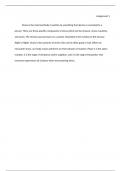Exam (elaborations)
Test Bank - Psychiatric Nursing: Contemporary Practice, 7th Edition (Ann Boyd, 2022), Chapter 1-43 | All Chapters
- Course
- Institution
- Book
Test Bank - Psychiatric Nursing: Contemporary Practice, 7th Edition (Ann Boyd, 2022), Chapter 1-43 | All Chapters
[Show more]




